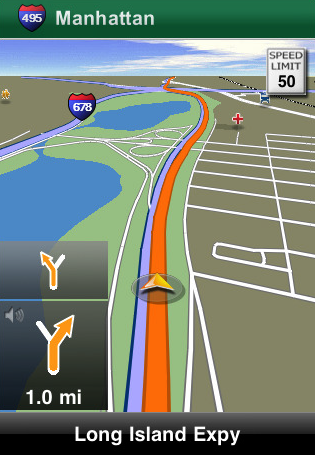Is Any iPhone App Worth $70?
 Friday, August 7, 2009 at 1:16PM
Friday, August 7, 2009 at 1:16PM Two weeks ago I did something I NEVER thought I would do. I paid $70 for an iPhone app! I have always wished for a turn-by-turn solution for the iPhone and held off buying a stand-alone Garmin or TomTom for my car. I settled for using the built-in Maps app when I needed to find something. Since the aforementioned purchase of MobileNavigator by Navigon AG, (iTunes link) I’ve been glad I waited. Paired with Kensington’s LiquidAUX car kit ($80 list, $50 on Amazon), the iPhone 3GS is a complete in-car solution for phone, internet, entertainment and now, navigation. For example, my family and I were driving through an unfamiliar state last weekend being directed by MobileNavigator while my daughter was surfing on her tethered laptop as the wife and I listened to our favorite podcast (NoAgenda). The iPhone handled the load just fine and the Kensington car kit kept the battery at 100% and held the screen at a good viewing angle, easily within reach. The steering wheel-mounted iPod controls worked flawlessly though I found myself wanting a couple more controls. The RF remote that comes with the Kensington car kit has buttons for play/pause, skip forward, skip back and shuffle.
Paired with Kensington’s LiquidAUX car kit ($80 list, $50 on Amazon), the iPhone 3GS is a complete in-car solution for phone, internet, entertainment and now, navigation. For example, my family and I were driving through an unfamiliar state last weekend being directed by MobileNavigator while my daughter was surfing on her tethered laptop as the wife and I listened to our favorite podcast (NoAgenda). The iPhone handled the load just fine and the Kensington car kit kept the battery at 100% and held the screen at a good viewing angle, easily within reach. The steering wheel-mounted iPod controls worked flawlessly though I found myself wanting a couple more controls. The RF remote that comes with the Kensington car kit has buttons for play/pause, skip forward, skip back and shuffle.
MobileNavigator is a very well done implementation of Navigon’s turn-by-turn and POI system used on their standalone devices. The look and feel is almost identical and the 3GS does an excellent job acquiring satellites and updating the screen. I haven’t seen the actual specification but by my observation the map screen updates multiple times per second in both 2D and 3D modes. No, the 3D graphics aren’t the best I’ve seen, but that sort of thing is just fluff anyway. If you spend time to admire all the pretty pictures on your nav, you’ll probably wind up in a ditch or attempting to occupy the same space as the car ahead of you. For me, the nice female voice telling me when to change course is good enough. Finding things with MobileNavigator is easy too. Like any nav, you can enter a street address or search for points of interest (POI) and Navigon’s database is as complete as any I’ve used. So far I’ve tested MobileNavigator in and around Houston and all over Kansas (from Wichita to Abilene to KC) on a recent family reunion outing. Even in the middle of B.F. Kansas, including some unpaved county roads, the MobileNavigator maps were accurate and concise. The only trouble I had with the app was finding a Tex-Mex restaurant in Kansas. Turns out, there aren’t any!
So, did I spend my $70 wisely? I think so, especially when you consider the cost of even the cheapest standalone nav. Navigon, Garmin and TomTom all offer devices with similar features to MobileNavigator for about $150, but that’s one more device to plug in that I’d rather avoid. I always have my iPhone with me and I use it for entertainment in my car so much I can’t remember which stations my radio buttons are for. MobileNavigator, in combination with the Kensington car kit lets me use some of the phone’s iPod functions while navigating as long as I load a playlist or audio track first. If Apple would stop playing “phone Nazi” and allow some degree of multitasking things would work even better. For now, changing a playlist or selecting different media means exiting MobileNavigator, selecting media then restarting MobileNavigator after the new audio begins playing. To avoid that procedure I tend to select longer playlists or podcasts. Consequently, my butt usually wears out when driving long before one of my playlists is finished. An incoming phone call forces MobileNavigator to exit, but it restarts as soon as you hang up. There is only a few (about 10 on the 3GS) second delay as the app restarts so it isn’t too annoying. If you were navigating a route, the app picks up where you left off without bothering you.
MobileNavigator is no lightweight when it comes to sheer size. The download is 1.3 GB and the install size is somewhere around 1.6. It obviously packs its maps and POI database, unlike the phone company’s offering. AT&T has their own turn-by-turn navigation app and the (2.3 MB) app itself is free. The privilege of using it costs $10 per month and is an add-on to the already ludicrous AT&T contract. If you have an iPhone 3G or 3GS and need a nav, MobileNavigator’s $70 price tag is money well spent.





